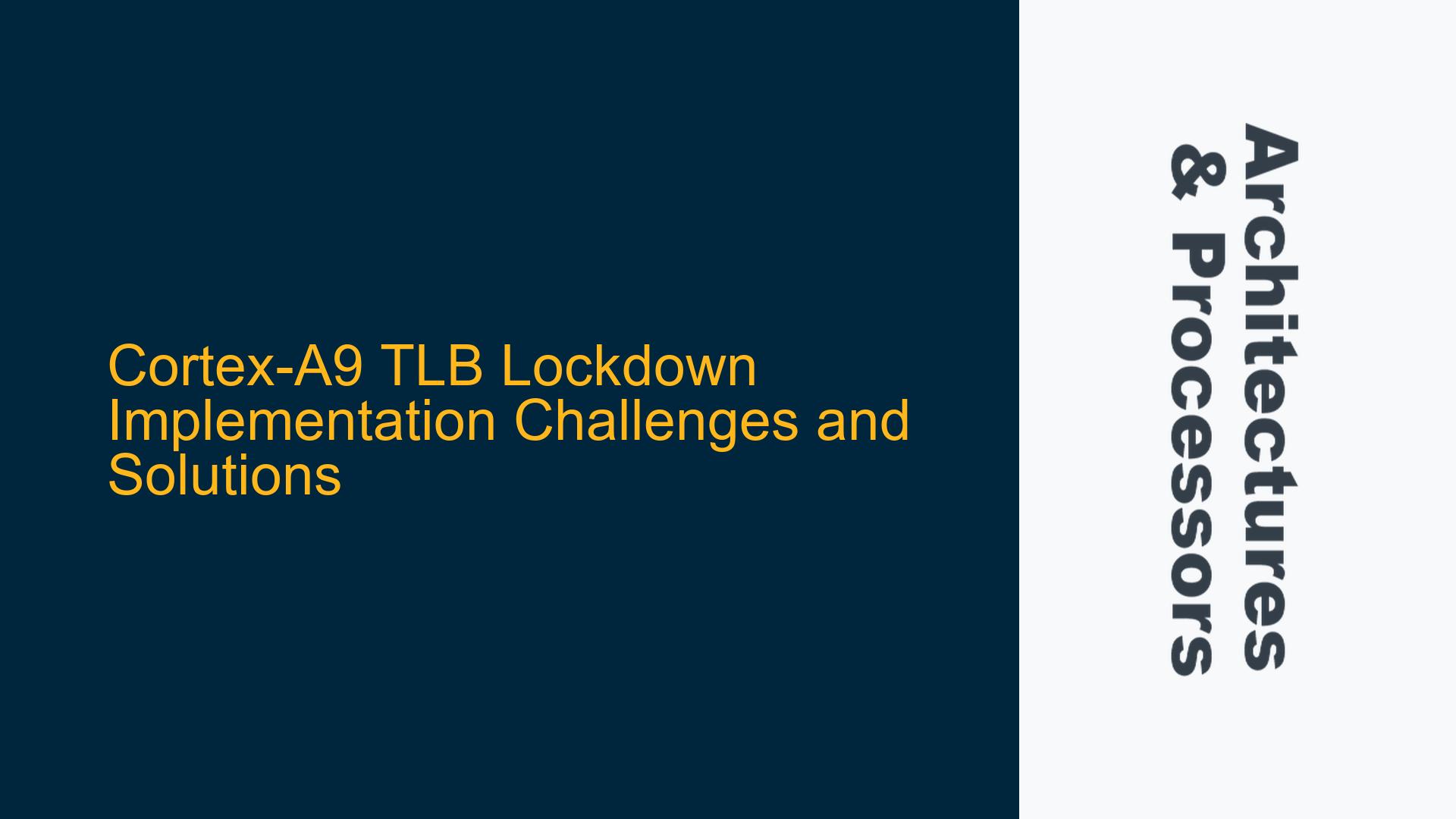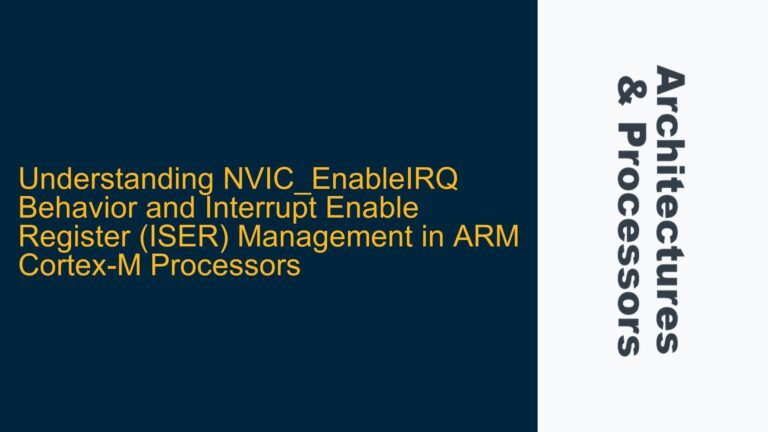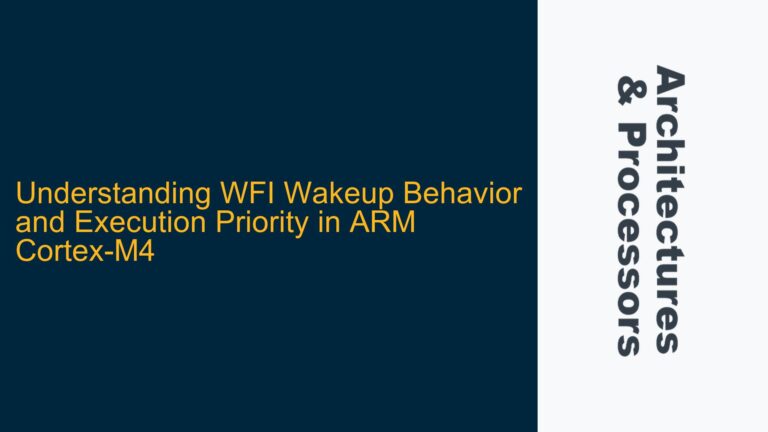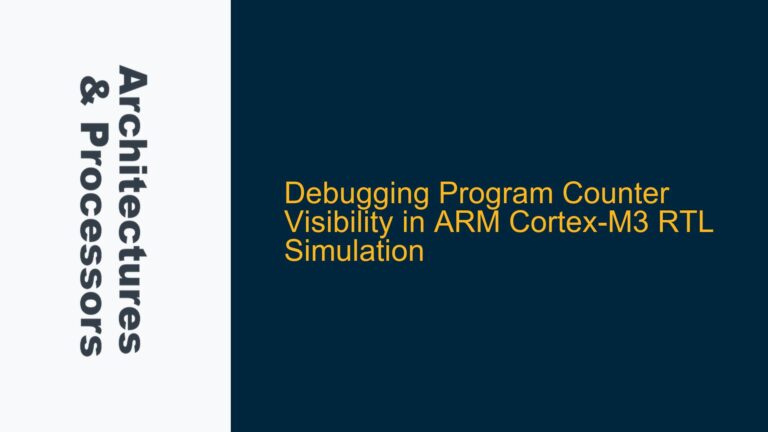Cortex-A9 TLB Lockdown Mechanism and Implementation Issues
The Cortex-A9 processor, part of ARM’s Cortex-A series, is widely used in embedded systems for its balance of performance and power efficiency. One of its advanced features is the Translation Lookaside Buffer (TLB), which accelerates virtual-to-physical address translation. However, implementing TLB lockdown in the Cortex-A9 can be challenging due to differences in its architecture compared to earlier processors like the Cortex-A8 and ARM1136JF. TLB lockdown is a technique used to ensure that critical translation entries remain in the TLB, preventing them from being evicted and thus improving deterministic performance for real-time applications.
The Cortex-A9 Technical Reference Manual (TRM) does not provide a detailed TLB lockdown method, unlike the Cortex-A8 and ARM1136JF manuals. This lack of documentation has led to confusion and implementation difficulties for developers attempting to port TLB lockdown techniques from older ARM cores to the Cortex-A9. The primary issue revolves around the sequence of operations required to lock down TLB entries, including invalidating the TLB, configuring the lockdown registers, and ensuring that the entries remain locked during runtime.
Developers often follow a sequence derived from Cortex-A8 or ARM1136JF documentation, which involves steps such as invalidating the TLB, setting the preserve bit, selecting the lockdown region, and writing to the TLB lockdown registers. However, this approach does not always yield the expected results on the Cortex-A9, leading to questions about the correctness of the method and potential pitfalls in the implementation.
Interrupt Handling and TLB Lockdown Sequence Timing
One of the critical factors affecting TLB lockdown implementation on the Cortex-A9 is the timing and handling of interrupts during the lockdown sequence. The Cortex-A9, like other ARM processors, relies on precise timing and atomicity when performing operations that modify the TLB or its associated control registers. If interrupts are not properly managed during the TLB lockdown sequence, the processor may context-switch or execute other tasks that interfere with the lockdown process, leading to inconsistent or failed lockdowns.
The Cortex-A9’s TLB lockdown mechanism involves multiple steps, including invalidating the TLB, configuring the lockdown registers, and writing the desired translation entries. Each of these steps must be executed atomically to ensure that no other process or interrupt modifies the TLB or its control registers during the sequence. Failure to lock interrupts during this process can result in race conditions, where the TLB state is altered by an interrupt handler or another thread, rendering the lockdown ineffective.
Additionally, the Cortex-A9’s TLB architecture may introduce subtle differences in how lockdown operations are handled compared to older ARM cores. For example, the Cortex-A9 uses a unified TLB for both instruction and data translations, whereas some older cores have separate TLBs. This architectural difference can affect how lockdown operations are performed and how the TLB entries are managed. Developers must account for these differences when porting TLB lockdown techniques from older cores to the Cortex-A9.
Implementing Robust TLB Lockdown on Cortex-A9
To implement TLB lockdown successfully on the Cortex-A9, developers must follow a carefully designed sequence of operations that accounts for the processor’s architectural nuances and ensures atomicity during critical sections. The following steps outline a robust approach to TLB lockdown on the Cortex-A9:
-
Disable Interrupts: Before beginning the TLB lockdown sequence, disable interrupts to prevent context switching or interference from interrupt handlers. This ensures that the lockdown sequence executes atomically without interruption.
-
Invalidate TLB Entries: Use the appropriate CP15 instructions to invalidate the TLB entries associated with the address space being locked down. This step ensures that the TLB is in a known state before configuring the lockdown registers.
-
Configure TLB Lockdown Registers: Write to the Cortex-A9’s TLB lockdown registers to set the preserve bit and select the lockdown region. This step prepares the TLB for the lockdown operation and ensures that the specified entries will not be evicted.
-
Write Lockdown TLB Entries: Use the CP15 instructions to write the desired translation entries into the TLB. This step populates the TLB with the translations that need to be locked down.
-
Finalize Lockdown Configuration: After writing the TLB entries, finalize the lockdown configuration by clearing the preserve bit and setting the lockdown region. This step ensures that the TLB entries remain locked and are not modified by subsequent operations.
-
Re-enable Interrupts: Once the TLB lockdown sequence is complete, re-enable interrupts to restore normal operation. This step ensures that the system can handle interrupts and other tasks while maintaining the locked TLB entries.
By following this sequence, developers can achieve reliable TLB lockdown on the Cortex-A9. However, it is essential to validate the implementation through rigorous testing, including stress testing with high interrupt loads and real-time task scheduling, to ensure that the TLB entries remain locked under all conditions.
Debugging and Validating TLB Lockdown on Cortex-A9
Debugging TLB lockdown issues on the Cortex-A9 requires a systematic approach to identify and resolve potential problems. The following steps outline a comprehensive debugging and validation process:
-
Verify Interrupt Handling: Ensure that interrupts are correctly disabled and re-enabled during the TLB lockdown sequence. Use debug tools to monitor interrupt activity and confirm that no interrupts occur during the critical section.
-
Check TLB State: Use CP15 instructions to read the TLB state before and after the lockdown sequence. Verify that the TLB entries are correctly invalidated, written, and locked. Compare the TLB state with the expected values to identify discrepancies.
-
Monitor Performance Counters: Use the Cortex-A9’s performance counters to monitor TLB activity, including hits, misses, and evictions. This data can provide insights into whether the TLB entries are being locked and used as intended.
-
Stress Testing: Conduct stress testing with high interrupt loads, multiple threads, and real-time tasks to evaluate the robustness of the TLB lockdown implementation. Monitor the system for any signs of TLB corruption or unexpected behavior.
-
Review Architectural Differences: Compare the Cortex-A9’s TLB architecture with that of older ARM cores to identify any differences that may affect the lockdown implementation. Adjust the implementation as needed to account for these differences.
-
Consult ARM Documentation and Community: Refer to the Cortex-A9 Technical Reference Manual and ARM community forums for additional insights and guidance. Engage with other developers who have implemented TLB lockdown on the Cortex-A9 to share experiences and solutions.
By following this debugging and validation process, developers can identify and resolve issues with TLB lockdown on the Cortex-A9, ensuring reliable and deterministic performance for real-time applications.
Conclusion
Implementing TLB lockdown on the Cortex-A9 requires a deep understanding of the processor’s architecture and careful attention to timing and atomicity. By following a robust sequence of operations, disabling interrupts, and validating the implementation through rigorous testing, developers can achieve reliable TLB lockdown and optimize performance for real-time applications. Debugging and validation are critical to ensuring that the TLB entries remain locked under all conditions, providing the deterministic behavior required for mission-critical systems.






